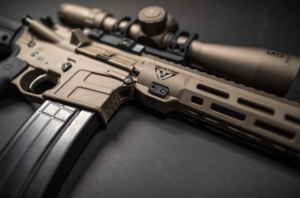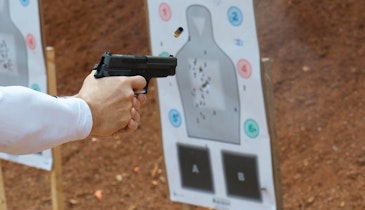The business of selling AR-15 rifles is getting tough. By my completely unscientific estimate, there are 976.23 trillion companies making different types of Modern Sporting Rifles. That tsunami of supply, combined with the fact that Hillary didn’t win, has them overflowing the warehouse doors and spilling onto sidewalk sales across the country.
As an economics major in college with a GPA assuredly more than 1.3, I can attest that a big and readily available supply of something will cause the price to fall. While I can’t say that Federal developed the new 224 Valkyrie cartridge as a sales aid to the AR-15 marketing cause, I do suspect that it can help, given the unique and very high- end performance characteristics of the
Valkyrie. What’s a Valkyrie? Being mostly Norwegian, I know that mythical female figures called Valkyries flew around on horses deciding who would live and die on Norse battlefields. Half of those chosen to eat it in battle would then end in a giant mead hall called Valhalla waiting to fight some epic end-of-times battles.
I also know the Air Force designed one of the coolest experimental planes ever and called it the XB-70 Valkyrie. Capable of flying thousands of miles at speeds over Mach 3, it was intended to outrun interceptor planes and pass by radar installations too fast for the enemy to react. Unfortunately, the development of surface to air missiles rained on that parade, and only two were built. One crashed. The other is on display at Wright Patterson Air Force Base outside of Dayton, Ohio. It’s a highly recommended trip. Given those two examples of Valkyries, I’m going to choose to believe that the cartridge pays homage to the XB-70 because of its long-range velocity and performance characteristics. Federal’s opinion may differ.
Yawn. Another cartridge. “New” cartridges come and go like prime-time game shows. So what? It costs a lot of inventory dollars to carry a new caliber when you consider the guns, a respect- able variety of ammunition, reloading supplies and other accessories. How do you know this one will be worthy of the trouble and expense? New cartridges have to have compelling features and functionality that are “uniquely different enough” for customers to care.
Here’s what I think is interesting and compelling about the 224 Valkyrie: it’s designed to go far with minimal impact from wind and gravity. “What?” You say? “Lots of cartridges already exist that offer great long-range performance! Why do we need another one?” Here’s why this one is different: It’s designed to work with a standard AR-15 platform.

The 224 Valkyrie is designed to go far with minimal impact from wind and gravity while working with the standard AR-15 platform.
Let’s take a look at the details behind that.
The Valkyrie is based on the 6.8 SPC cartridge case that was in turn developed around the .30 Remington. The case is a bit fatter than a .223 Remington, but the overall length of the cartridge is the same. That’s important because the 224 Valkyrie can fit in standard AR magazine wells. Like the 6.8 SPC, you’ll want to use a 6.8 SPC magazine for feeding reliability, and you’ll have a slightly smaller capacity with somewhere around 25 rounds in a standard 30-round-size magazine. All of that means that you can add a 224 Valkyrie upper receiver to a standard AR-15 lower. The only difference is the 6.8 SPC bolt and, of course, the barrel. While the bore diameter is the same as .223 Remington, at .224 inches, the chamber is cut to accommodate the bigger and fatter Valkyrie cartridge.
Before talking about performance, which is where the Valkyrie shines, we’ve got to establish some baselines for the environment and atmospheric conditions. The performance of any rifle cartridge will be radically different for someone living near the Mile High City of Denver compared to the swamplands of South Carolina where I live.
Let’s consider the performance characteristics of the 224 Valkyrie from an “average” perspective. The average elevation of the United States is 2,493 feet, according to Wikipedia. We’ll use that elevation and a temperature of 60 degrees for all the math from here on out. If you live in Nepal, which averages 10,712 above sea level, your results are going to be better. Way better. We’ll also assume a zero range of 100 yards, since that what’s available to most people, and an MSR optic height of 2.8 inches.
The standard match load of the Valkyrie calls for a 90-grain bullet. For example, the Federal Premium match load uses a 90-grain Sierra MatchKing. That’s a long and skinny bullet with a high ballistic coefficient, so it carries velocity well down range. This particular load is rated to have a muzzle velocity of 2,700 feet per second. In our “average” conditions, that means it’ll stay supersonic out past 1,200 yards. The higher you are, the longer that supersonic range stretches. If you’re in Nepal, your supersonic reach exceeds 1,600 yards. The supersonic range is a big deal because bullet drop is amazingly predictable right up until it encounters the sound barrier — then things start to get a bit wonky.
BULLET DROP
How different is the 224 Valkyrie from other rounds that operate in a standard AR-15 chassis? Let’s compare a standard 55-grain FMJ with a 3,100 fps muzzle velocity, a 77-grain match bullet with 2,750 fps muzzle velocity, and the Federal Premium 90-grain 224 Valkyrie at 2,700 feet per second.
Beyond 600 yards, things really start to shine for the Valkyrie, at least in comparison to other .223 Remington loads. By 1,200 yards, the difference in drop between the Valkyrie and a standard 55-grain .223 FMJ is a whopping 13.5 feet.
WHAT ABOUT WIND?
Let’s assume we have a 10 mph crosswind from exactly the three o’clock position. Running the same numbers, we see the following wind deflection, measured in inches. A few inches here and there and pretty soon we’re talking about some real performance differences. It’s nice to have a flatter shooting cartridge, but in reality, accounting for bullet drop is the easy part. Up until the transonic range, it’s a simple adjustment that works every time because gravity is constant.
Where that “flatness” matters is extending usable range by moving that transition to subsonic flight farther down range — an extra 500 yards when compared to the 55-grain .223 Remington. The other big benefit is the windage. Since accounting for wind relies more on shooter experience and skill, any cartridge that exhibits minimal lateral movement is going to be more forgiving in a crosswind. At the 1,000-yard mark, the Valkyrie has just over half the wind deflection as a 55-grain .223 Remington.
Using our standard math, here are a few Valkyrie milestones. It’s carrying supersonic velocity past 1,200 yards. Flight time to reach that 1,200-yard mark is 2.09 seconds. It’s still packing 1,000 foot-pounds of kinetic energy at 300 yards and 500 foot-pounds to about 775 yards.
To put that in perspective, a standard 55-grain FMJ goes subsonic at about 870 yards in our average environment after 1.38 seconds of flight time. It delivers 1,000 foot-pounds of energy to just 70 or 80 yards and 500 foot-pounds to just under 400 yards.
So, in summary, the 224 Valkyrie has the ability to make a standard AR perform like a respectable long-range gun normally built on larger AR-10 platforms. Not only does the user get some flexibility in using standard AR lower receivers, but the recoil is also a lot less than that of cartridges like 6.5mm Creedmoor chambered in larger AR-10 rifles. How much less? Try half. That’s significant, especially for competitors who want to watch their shot impacts through the scope and get quick follow-up shots on the way.
Rifle manufacturers seem to see the benefits too — they’re jumping on board with new models in a big way. Let’s take a look at a few coming to market.
ASHBURY PRECISION ORDINANCE
Ashbury Precision Ordnance is jumping into the Valkyrie market with two differ- ent models just for starters. The Limited Edition SHADOW-6 Saber M700 rifle comes from its custom shop and was designed under guidance from notable sniper, Jim Gilliland. It’s a bolt rifle that has some AR-like attributes including a Mil-Spec receiver extension tube and M-LOK handguard. Since it requires no internal buffer parts, the stock is not only adjustable for length of pull, but also foldable. The company is also adding 224 Valkyrie to its Supra line.
The Mk4 DTR2 goes pure long distance with its 24-inch, 1:7-inch twist rate 416SS salt bath nitrided barrel. The gas system is rifle length and has a standard .223 bore threaded with the usual 1/2- inch -28 thread pattern in case customers want to replace the included SV muzzle brake. Magpul supplies the furniture with an MOE pistol grip and PRS stock. The Mk4 DTR2 also ships with ambidextrous safety/ selector levers and charging handle. Last but not least is a Geissele SSA trigger. MSRP: $1,699.95
LWRC
LWRC announced theValkyrie 224 DI lineup. Based on the company’s Six8 platform, the new rifles are available in black, flat dark earth, olive drab green, patriot brown and tungsten gray. The rifle is built around a 20.1-inch cold-hammer-forged, unfluted, NiCorr-treated barrel with a rifle-length gas system. A 16-inch M-LOK handguard offers a full-length top rail. Other extras include a snakeskin textured pistol grip and all primary controls are ambidextrous. MSRP: $1,995 to $2,148
PALMETTO STATE ARMORY
PSA is taking advantage of the lower receiver compatibility and offering a few different packagings of a 224 Valkyrie upper receiver. All current models have an 18-inch 1:7-inch twist stainless barrel and are available with a variety of KeyMod and M-LOK handguard options. MSRP: $449.99
SAVAGE
Last year, Savage launched the MSR15 line. This year, it’s adding two rifles chambered in 224 Valkyrie to it. The standard MSR15 224 Valkyrie features an 18-inch carbon barrel to eke out every bit of potential velocity. The receivers are coyote tan Cerakote while a two- stage match trigger and Hogue pistol grip round out the package. MSRP: $1,499
The MSR15 Recon LRP combines an 18-inch barrel, two-stage trigger and free float handguard. The LRP also adds an adjustable gas block that allows the user to tweak the action to specific loads. MSRP: $1,249
STAG ARMS
Stag offers both a standard and left-hand version of the Stag 15 Valkyrie Rifle. It features an 18-inch 416R Stainless Steel and fluted heavy barrel with button rifling. Like many other models, the Stag 15 Valkyrie comes with Magpul accessories including a PRS Stock. The pistol grip is from Hogue and the rifle includes a two-stage match trigger. The company also offers 224 Valkyrie uppers and rifle kits for home assembly. MSRP: 1,179.99
These are just a few of the early entrants. Based on SHOT Show 2018 early looks and hallway conversations, we can expect to see plenty more from companies, possibly including Barrett, Ruger, LaRue, MasterPiece Arms, Seekins Precision and others. Time will tell, but I believe this new offering has some legs in the short run and staying power in the long. At the rate, long-range shooting interest is growing, this viable option for the standard AR platform is sure to be a winner.






